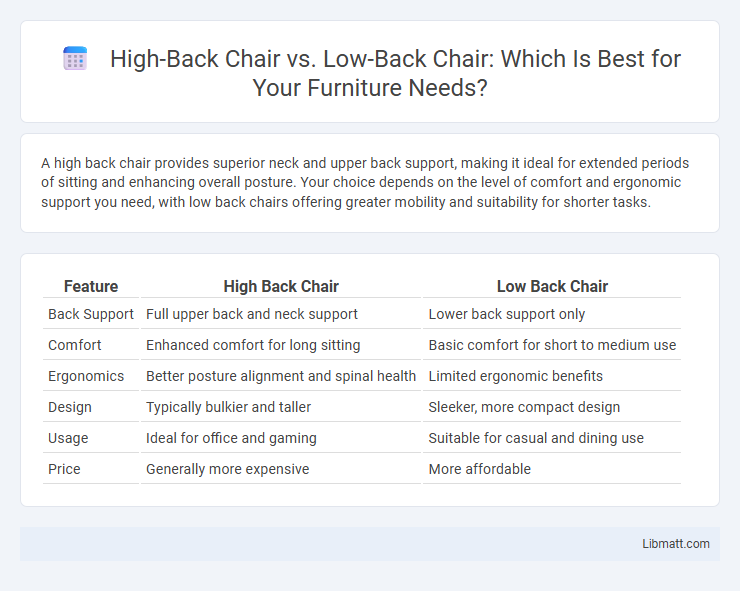A high back chair provides superior neck and upper back support, making it ideal for extended periods of sitting and enhancing overall posture. Your choice depends on the level of comfort and ergonomic support you need, with low back chairs offering greater mobility and suitability for shorter tasks.
Table of Comparison
| Feature | High Back Chair | Low Back Chair |
|---|---|---|
| Back Support | Full upper back and neck support | Lower back support only |
| Comfort | Enhanced comfort for long sitting | Basic comfort for short to medium use |
| Ergonomics | Better posture alignment and spinal health | Limited ergonomic benefits |
| Design | Typically bulkier and taller | Sleeker, more compact design |
| Usage | Ideal for office and gaming | Suitable for casual and dining use |
| Price | Generally more expensive | More affordable |
Introduction to High Back and Low Back Chairs
High back chairs provide extended support for the upper back, neck, and head, promoting better posture and reducing strain during prolonged sitting. Low back chairs focus primarily on lumbar support, offering greater freedom of movement and a more compact design suitable for tasks requiring frequent turning. Your choice between high back and low back chairs depends on the level of comfort and ergonomic support you need for your workspace.
Key Differences Between High Back and Low Back Chairs
High back chairs provide extensive support to the upper back, neck, and head, making them ideal for extended sitting periods and promoting better posture. Low back chairs focus on lumbar support, allowing greater freedom of movement and a more compact design suitable for smaller workspaces. Your choice between high back and low back chairs should consider ergonomic needs, workspace size, and the duration of use to ensure maximum comfort and productivity.
Ergonomic Benefits of High Back Chairs
High back chairs provide superior ergonomic benefits by offering full support to the spine, including the neck and upper back, reducing strain and promoting better posture. These chairs help alleviate pressure points and prevent discomfort during extended sitting periods, making them ideal for office environments. Choosing a high back chair can enhance your comfort and productivity by maintaining spinal alignment and reducing fatigue.
Advantages of Low Back Chairs
Low back chairs offer greater mobility and flexibility, allowing users to easily swivel and turn without obstruction. They promote better airflow and reduce heat buildup, enhancing comfort during prolonged sitting. These chairs are typically lighter and more compact, making them ideal for smaller workspaces and easy to move around.
Support and Comfort: Which Chair Wins?
High back chairs provide superior support by aligning with the natural curve of the spine and offering full upper back, neck, and head support, which reduces strain during extended sitting periods. Low back chairs target lumbar support and encourage active sitting but may lack sufficient upper back and neck support, leading to discomfort over time. For enhanced comfort and spinal health, high back chairs generally win, especially in environments requiring prolonged sitting.
Recommended Usage Environments
High back chairs are recommended for office environments where prolonged sitting and back support are essential, such as executive offices and conference rooms. Low back chairs suit settings with shorter seating durations like reception areas, casual meeting spaces, and break rooms. Ergonomic considerations favor high back chairs in environments requiring enhanced lumbar and upper back support for improved posture.
Style and Aesthetics Comparison
High back chairs offer a commanding presence and a classic, formal aesthetic that enhances executive office spaces or traditional interiors. Low back chairs present a sleek, modern look that complements minimalist and contemporary decor while promoting visual openness in smaller rooms. Choosing between the two depends on the desired style impact and the specific design elements of the environment.
Price and Durability Considerations
High back chairs typically cost more due to their larger size, enhanced ergonomic features, and more complex construction, making them a premium investment for long-term comfort. Low back chairs offer a more budget-friendly option, but they may sacrifice some durability and support, often using lighter materials that wear out faster under heavy use. Choosing between high back and low back chairs depends on balancing upfront price with expected lifespan and maintenance costs, where high back chairs generally provide better long-term value for frequent users.
Health Impacts of Chair Selection
Choosing a high back chair provides superior support for your spine, reducing strain on the neck and upper back, which can help prevent musculoskeletal disorders and improve posture during prolonged sitting. Low back chairs may encourage more movement and flexibility but often lack adequate lumbar and upper back support, potentially leading to discomfort and increased risk of chronic back pain. Your health benefits significantly from selecting a chair that aligns with ergonomic principles, prioritizing spinal alignment and pressure distribution to enhance comfort and reduce fatigue.
How to Choose the Right Chair for You
Choosing the right chair involves assessing your posture needs and workspace ergonomics, where a high back chair provides superior neck and upper back support, ideal for long hours at the desk. Low back chairs promote more active sitting and are better suited for shorter periods or minimal support requirements. Your decision should balance comfort, lumbar support, and the duration of use to enhance productivity and reduce strain.
high back chair vs low back chair Infographic

 libmatt.com
libmatt.com